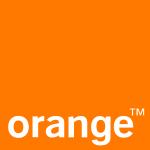Orange Romania
You can help expand this article with text translated from the corresponding article in Romanian. (March 2022) Click [show] for important translation instructions.
|
 | |
| Company type | Subsidiary of Orange S.A. |
|---|---|
| Industry | Telecommunications |
| Founded | 1997 (as Mobilrom) |
| Headquarters | Bucharest, Romania |
Key people | Julien Ducarroz (CEO) |
| Revenue | |
| 41,200,000 Euro (2018) | |
Number of employees | 2,366 (2018) |
| Parent | Orange Belgium (80%) Ministry Of Research, Innovation And Digitalization (20%) [2] |
| Website | www |

Orange România is a broadband Internet service provider and mobile provider in Romania. It is Romania's largest GSM network operator[3] which is majority owned by Orange S.A. that also uses some of the Telekom Romania infrastructure, the biggest initial investor, who gradually increased its ownership.
Between 1997 and April 2002, the company was named Mobil Rom, operated under two brand names Dialog (for monthly subscription plans, in Romanian means "dialogue") and Alo (for prepay services). In April 2002, after France Télécom gained a majority stake it was re-branded to comply with the group's global strategy. As of December 2012, Orange Romania has 10.3 million mobile subscribers.[1]
Orange is in head-to-head competition with Vodafone Romania for one of the most dynamic mobile telephony markets in south eastern Europe. Currently the mobile penetration is at about 115% (active users only). Orange edged ahead of Vodafone (formerly Connex) in terms of number of subscribers in September 2004. They are the main mobile telephony operators, with Orange having a market share of almost 38% of the total market (active and inactive users).
Orange România also controls 4% of the Moldovan operator Orange Moldova.
YOXO
[edit]In 2020 Orange Romania launches it`s branch YOXO Romania as a virtual mobile network.[4]
Radio frequency summary
[edit]The following is a list of known frequencies which Orange uses in Romania:
| MCC | MNC | Frequency | Band number | Protocol (Downlink/Uplink speed) | Class | Notes |
|---|---|---|---|---|---|---|
| 226 | 10 | 900 MHz | 8 | GSM/GPRS/EDGE | 2G | |
| 226 | 10 | 900 MHz | 8 | UMTS/HSPA/HSPA+ (21.6 Mbit/s/5.76 Mbit/s) | 3G | 3G Phase-out 2025[5] |
| 226 | 10 | 2100 MHz | 1 | UMTS/HSPA/HSPA+/DC-HSDPA (43.2 Mbit/s/5.76 Mbit/s) | 3G | 3G Phase-out 2025[5] |
| 226 | 10 | 1800 MHz | B3 | LTE (142 Mbit/s/47.5 Mbit/s) | 4G | Downlink speeds can be up to 355.6 Mbit/s through CA_3A_7A_20A |
| 226 | 10 | 2600 MHz | B7 | LTE (992 Mbit/s/470.5 Mbit/s) | 4G | Downlink speeds can be up to 355.6 Mbit/s through CA_3A_7A_20A |
| 226 | 10 | 800 MHz | B20 | LTE (71.2 Mbit/s/25 Mbit/s) | 4G | Downlink speeds can be up to 500Mbit/s through CA_3A_7A_20A |
| 226 | 10 | 700 MHz | B28 | LTE (71.2 Mbit/s/25 Mbit/s) | 4G | Downlink speeds can be up to 150Mbit/s |
| 226 | 10 | 1500 MHz | B32 | LTE | 4G | Limited network development (2024-03) |
| 226 | 10 | 1800 MHz | n3 | 5G NSA | 5G | |
| 226 | 10 | 2600 MHz | n7 | 5G NSA | 5G | |
| 226 | 10 | 800 MHz | n20 | 5G NSA | 5G | |
| 226 | 10 | 700 MHz | n28 | 5G NSA | 5G | |
| 226 | 10 | 3500 MHz | n78 | 5G NSA | 5G |

See also
[edit]References
[edit]- ^ a b "Financial indicators in Romania". Orange. 2013-06-13. Archived from the original on August 11, 2013. Retrieved 2013-08-10.
- ^ "Orange anunță finalizarea fuziunii dintre Orange Romania S.A. și Orange Romania Communications S.A. Pe 1 iunie 2024". 30 May 2024.
- ^ "Orange: Growth undermined by roaming and interconnection". Ziarul Financiar. Archived from the original on 2008-05-10. Retrieved 2008-05-18.
- ^ "Orange anunță lansarea YOXO" [Orange announces the launch of YOXO]. Europa FM. March 26, 2020.
- ^ a b "Orange va renunța gradual la tehnologia 3G". newsroom.orange.ro. January 22, 2024.
